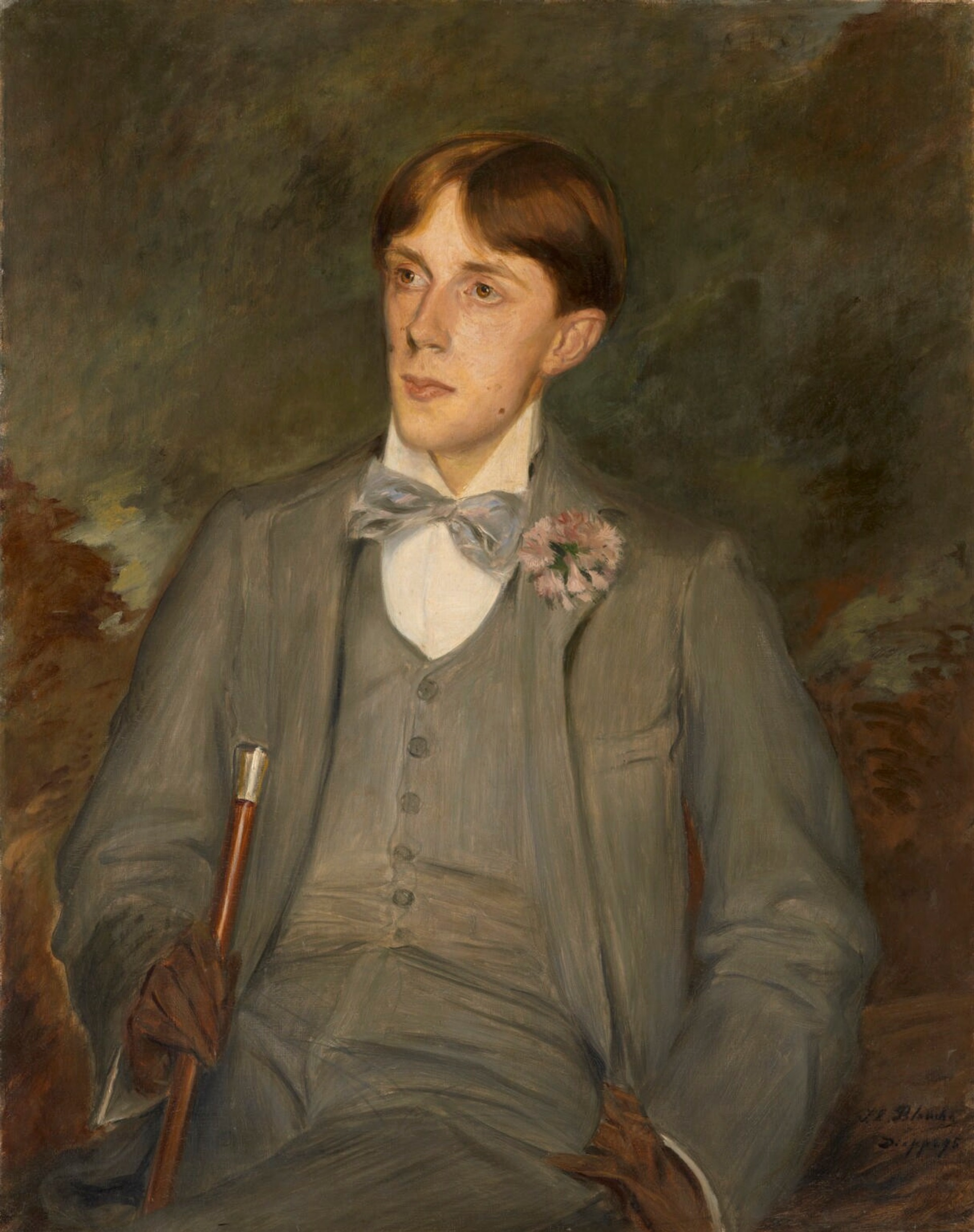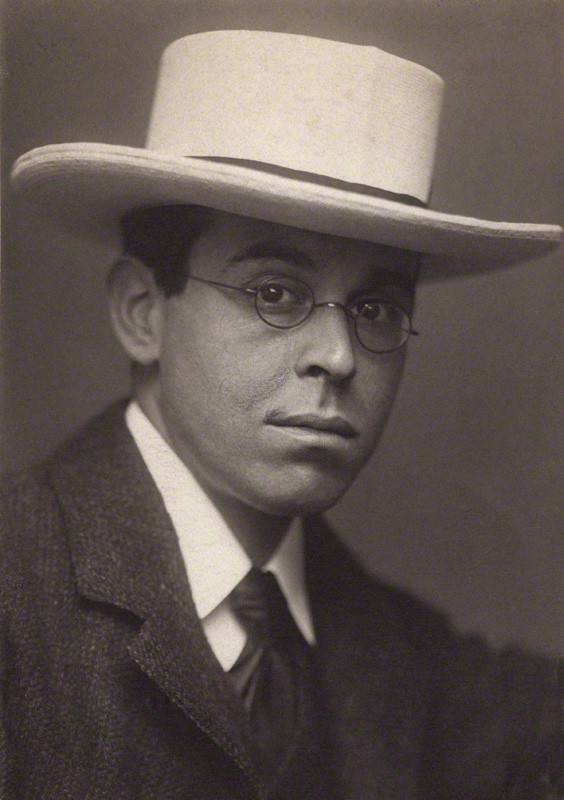|
A Caprice
''A Caprice'' is the only known oil painting by English artist Aubrey Beardsley, made c.1894. It has been held by the Tate Gallery since 1923. Unusually, the work is painted with two different images, one on each side of the canvas. The unfinished surreal images both have covert sexual imagery. The painting on the front of the canvas, ''A Caprice'', is believed to have been painted first. It depicts a scene in a theatre. A woman in a black dress with green details is being led by a short black-faced person in a red costume towards an arched doorway opening onto an auditorium. The woman has a white feather in her black hat, and is holding a white muff; her pallid white face is shown in profile, with prominent red lips and cheeks. The painting seems to be inspired by the first of Beardsley's three images depicting "The Comedy-Ballet of Marionnettes, as performed by the troupe of the Theatre-Impossible, posed in three drawings", which were published in the second volume of the ... [...More Info...] [...Related Items...] OR: [Wikipedia] [Google] [Baidu] |
The Yellow Book - 02
''The'' () is a grammatical article in English, denoting persons or things that are already or about to be mentioned, under discussion, implied or otherwise presumed familiar to listeners, readers, or speakers. It is the definite article in English. ''The'' is the most frequently used word in the English language; studies and analyses of texts have found it to account for seven percent of all printed English-language words. It is derived from gendered articles in Old English which combined in Middle English and now has a single form used with nouns of any gender. The word can be used with both singular and plural nouns, and with a noun that starts with any letter. This is different from many other languages, which have different forms of the definite article for different genders or numbers. Pronunciation In most dialects, "the" is pronounced as (with the voiced dental fricative followed by a schwa) when followed by a consonant sound, and as (homophone of the archaic pr ... [...More Info...] [...Related Items...] OR: [Wikipedia] [Google] [Baidu] |
Aubrey Beardsley
Aubrey Vincent Beardsley (21 August 187216 March 1898) was an English illustrator and author. His black ink drawings were influenced by Woodblock printing in Japan, Japanese woodcuts, and depicted the grotesque, the decadent, and the erotic. He was a leading figure in the Aestheticism, aesthetic movement which also included Oscar Wilde and James McNeill Whistler. Beardsley's contribution to the development of the Art Nouveau and poster art, poster styles was significant despite his early death from tuberculosis. He is one of the important Modern Style (British Art Nouveau style), Modern Style figures. Early life, education, and early career Beardsley was born in Brighton, Sussex, England, on 21 August 1872 and christened on 24 October 1872. His father, Vincent Paul Beardsley (1839–1909), was the son of a Clerkenwell jeweler; Vincent had no trade himself (partly owing to inherited tuberculosis, from which his own father had died aged only 40), and relied on a private income ... [...More Info...] [...Related Items...] OR: [Wikipedia] [Google] [Baidu] |
Tate Gallery
Tate is an institution that houses, in a network of four art galleries, the United Kingdom's national collection of British art, and international modern and contemporary art. It is not a government institution, but its main sponsor is the UK Department for Digital, Culture, Media and Sport. The name "Tate" is used also as the operating name for the corporate body, which was established by the Museums and Galleries Act 1992 as "The Board of Trustees of the Tate Gallery". The gallery was founded in 1897 as the National Gallery of British Art. When its role was changed to include the national collection of modern art as well as the national collection of British art, in 1932, it was renamed the Tate Gallery after sugar magnate Henry Tate of Tate & Lyle, who had laid the foundations for the collection. The Tate Gallery was housed in the current building occupied by Tate Britain, which is situated in Millbank, London. In 2000, the Tate Gallery transformed itself into the curre ... [...More Info...] [...Related Items...] OR: [Wikipedia] [Google] [Baidu] |
The Yellow Book
''The Yellow Book'' was a British quarterly literary periodical that was published in London from 1894 to 1897. It was published at The Bodley Head Publishing House by Elkin Mathews and John Lane, and later by John Lane alone, and edited by the American Henry Harland. The periodical was priced at 5 shillings (£, ) and lent its name to the "Yellow Nineties", referring to the decade of its operation. Significance ''The Yellow Book'' was a leading journal of the British 1890s; to some degree associated with aestheticism and decadence, the magazine contained a wide range of literary and artistic genres, poetry, short stories, essays, book illustrations, portraits, and reproductions of paintings. Aubrey Beardsley was its first art editor, and he has been credited with the idea of the yellow cover, with its association with illicit French fiction of the period. He obtained works by such artists as Charles Conder, William Rothenstein, John Singer Sargent, Walter Sickert, and Philip ... [...More Info...] [...Related Items...] OR: [Wikipedia] [Google] [Baidu] |
Beauty Spot
''Beauty Spot'' (French: ''Grains de beauté'') is a 1932 French musical comedy film directed by Pierre Caron and Léonce Perret and starring Simone Cerdan, Marfa d'Hervilly and Doris Morrey.Crisp p.391 It is a remake of the 1931 German film '' Opera Ball'' and is part of the operetta film genre. The film's sets were designed by Jacques Colombier. Cast * Simone Cerdan as Colette Dupont * Marfa d'Hervilly as Tante Aurélie * Doris Morrey as Pepita * Christiane Tourneur as Lily * Jeanne Fusier-Gir as Jacqueline * Roger Tréville as Jacques * Albert Duvaleix as Lucien Fortier * Marcel Lutrand as André * Marcel Lagrange as Durvy * Henri Richard as L'ambassadeur * André Roanne as Pierre Daumont * Netta Duchâteau * Louis Florencie * Nono Lecorre * George Rigaud Pedro Jorge Rigato Delissetche, [...More Info...] [...Related Items...] OR: [Wikipedia] [Google] [Baidu] |
Freud
Sigmund Freud ( , ; born Sigismund Schlomo Freud; 6 May 1856 – 23 September 1939) was an Austrian neurologist and the founder of psychoanalysis, a clinical method for evaluating and treating pathologies explained as originating in conflicts in the psyche, through dialogue between a patient and a psychoanalyst. Freud was born to Galician Jewish parents in the Moravian town of Freiberg, in the Austrian Empire. He qualified as a doctor of medicine in 1881 at the University of Vienna. Upon completing his habilitation in 1885, he was appointed a docent in neuropathology and became an affiliated professor in 1902. Freud lived and worked in Vienna, having set up his clinical practice there in 1886. In 1938, Freud left Austria to escape Nazi persecution. He died in exile in the United Kingdom in 1939. In founding psychoanalysis, Freud developed therapeutic techniques such as the use of free association and discovered transference, establishing its central role in the analytic proces ... [...More Info...] [...Related Items...] OR: [Wikipedia] [Google] [Baidu] |
William Rothenstein
Sir William Rothenstein (29 January 1872 – 14 February 1945) was an English painter, printmaker, draughtsman, lecturer, and writer on art. Emerging during the early 1890s, Rothenstein continued to make art right up until his death. Though he covered many subjects – ranging from landscapes in France to representations of Jewish synagogues in London – he is perhaps best known for his work as a war artist in both world wars, his portraits, and his popular memoirs, written in the 1930s. More than two hundred of Rothenstein's portraits of famous people can be found in the National Portrait Gallery collection. The Tate Gallery also holds a large collection of his paintings, prints and drawings. Rothenstein served as Principal at the Royal College of Art from 1920 to 1935. He was knighted in 1931 for his services to art. In March 2015 'From Bradford to Benares: the Art of Sir William Rothenstein', the first major exhibition of Rothenstein's work for over forty years, opened at Bra ... [...More Info...] [...Related Items...] OR: [Wikipedia] [Google] [Baidu] |
Pietro Longhi
Pietro Longhi (1702 or November 5, 1701 – May 8, 1785) was a Venetian painter of contemporary genre scenes of life. Biography Pietro Longhi was born in Venice in the parish of Saint Maria, first child of the silversmith Alessandro Falca and his wife, Antonia. He adopted the Longhi last name when he began to paint. He was initially taught by the Veronese painter Antonio Balestra, who then recommended the young painter to apprentice with the Bolognese Giuseppe Maria Crespi, who was highly regarded in his day for both religious and genre painting and was influenced by the work of Dutch painters. Longhi returned to Venice before 1732. He was married in 1732 to Caterina Maria Rizzi, by whom he had eleven children (only three of which reached the age of maturity). Among his early paintings are some altarpieces and religious themes. His first major documented work was an altarpiece for the church of San Pellegrino in 1732. In 1734, he completed frescoes in the walls and ceiling o ... [...More Info...] [...Related Items...] OR: [Wikipedia] [Google] [Baidu] |
Venetian Carnival
The Carnival of Venice ( it, Carnevale di Venezia) is an annual festival held in Venice, Italy. The carnival ends on Shrove Tuesday (''Martedì Grasso'' or Mardi Gras), which is the day before the start of Lent on Ash Wednesday. The festival is world famous for its elaborate masks. History According to legend, the Carnival of Venice began after the military victory of the Venetian Republic over the Patriarch of Aquileia, Ulrico di Treven in the year 1162. In honour of this victory, the people started to dance and gather in San Marco Square. Apparently, this festival started in that period and became official during the Renaissance. In the seventeenth century, the baroque carnival preserved the prestigious image of Venice in the world. It was very famous during the eighteenth century. It encouraged licence and pleasure, but it was also used to protect Venetians from present and future anguish. However, under the rule of the Holy Roman Emperor and later Emperor of Austria, ... [...More Info...] [...Related Items...] OR: [Wikipedia] [Google] [Baidu] |
Cambridge Street
Cambridge ( ) is a university city and the county town in Cambridgeshire, England. It is located on the River Cam approximately north of London. As of the 2021 United Kingdom census, the population of Cambridge was 145,700. Cambridge became an important trading centre during the Roman and Viking ages, and there is archaeological evidence of settlement in the area as early as the Bronze Age. The first town charters were granted in the 12th century, although modern city status was not officially conferred until 1951. The city is most famous as the home of the University of Cambridge, which was founded in 1209 and consistently ranks among the best universities in the world. The buildings of the university include King's College Chapel, Cavendish Laboratory, and the Cambridge University Library, one of the largest legal deposit libraries in the world. The city's skyline is dominated by several college buildings, along with the spire of the Our Lady and the English Martyrs Chu ... [...More Info...] [...Related Items...] OR: [Wikipedia] [Google] [Baidu] |
.png)

_(2).jpg)



_-_WGA22379.jpg)
